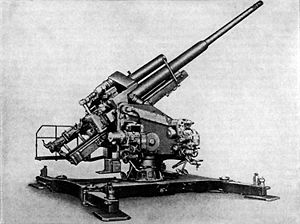12.8 cm FlaK 40
| 12.8 cm Flak 40 | |
|---|---|

A static mounted 12.8 cm Flak 40.
|
|
| Type | Anti-aircraft gun |
| Place of origin | Nazi Germany |
| Service history | |
| In service | 1942–45 |
| Used by | Nazi Germany |
| Wars | World War II |
| Production history | |
| Designer | Rheinmetall-Borsig |
| Designed | 1936 |
| Manufacturer | Rheinmetall-Borsig |
| Produced | 1942 |
| No. built | 1,125 |
| Variants | 12.8 cm FlaK 40 12.8 cm FlaK 40 Zwilling |
| Specifications | |
| Weight | 17,000 kg (37,478 lbs) |
| Length | 7.835 m (25 ft 8 in) |
| Barrel length | 61 calibers |
|
|
|
| Shell | 26 kilograms (57 lb) |
| Caliber | 128 mm (5.03 in) |
| Breech | Horizontal sliding |
| Recoil | Hydropneumatic |
| Carriage | Static or railcar mounted. |
| Elevation | -3 to +88 degrees |
| Traverse | 360 degrees |
| Muzzle velocity | 880 m/s (2,887 ft/s) |
| Maximum firing range | 10,675 m (35,025 ft) |
| Feed system | Power rammer |
The 12.8 cm FlaK 40 was a German World War II anti-aircraft gun. Although it was not produced in great numbers, it was one of the most effective heavy AA guns of its era.
Development of the gun began in 1936, with the contract being awarded to Rheinmetall Borsig. The first prototype gun was delivered for testing in late 1937 and completed testing successfully. The gun weighed nearly 12 tonnes in its firing position, with the result that its barrel had to be removed for transport. Limited service testing showed this was impractical, so in 1938 other solutions were considered.
The eventual solution was to simplify the firing platform, based on the assumption it would always be securely bolted into concrete. The total weight of the Flakzwilling twin-gun mount system reached 26.5 tonnes, making it practically impossible to tow cross-country. In the end, this mattered little since by the time the gun entered production in 1942, it was used in primary static defensive applications. There were four twin mounts on the fortified anti-aircraft Zoo Tower, and they were also on other flak towers protecting Berlin, Hamburg, and Vienna. During the Battle of Berlin, the guns on the Zoo Tower were used successfully to support ground forces, where the heavy 128 mm shells obliterated Soviet armor, especially when hit from the side. The rush to capture the Reichstag led to dozens of tanks being destroyed. Approximately 200 were mounted on railcars, providing limited mobility.
The gun fired a 27.9 kg (57.2-pound) shell at 880 m/s (2,890 ft/s) to a maximum ceiling of 14,800 m (48,556 ft). Compared with the 88 mm FlaK 18 & 36, the FlaK 40 used a powder charge four times as great.
...
Wikipedia
